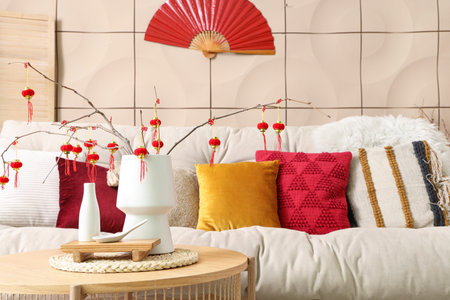Introduction: The Art of Outdoor Harmony
Across the United Kingdom, an ever-growing appreciation for mindful living has inspired many to transform their gardens into restorative sanctuaries. With British homes often blessed with lush lawns, heritage stonework, and vibrant borders, the garden has become more than a patch of green—it’s a cherished extension of one’s living space. As we seek solace and renewal amidst the daily hustle, attention is turning to how thoughtful design can elevate outdoor wellbeing. Here, Feng Shui—a time-honoured practice rooted in harmonising people with their environment—offers valuable insights. By blending ancient wisdom with quintessentially British sensibilities, homeowners are discovering that the careful placement of garden furniture and ornaments not only enhances beauty but also fosters positive energy and personal contentment. In this guide, we’ll explore how simple Feng Shui principles can help you curate a balanced, uplifting garden tailored to the UK’s unique cultural landscape.
2. Principles of Feng Shui for British Gardens
Feng Shui, the ancient Chinese art of spatial arrangement, can be thoughtfully adapted to enhance wellbeing in British gardens by considering both traditional concepts and the unique characteristics of UK outdoor spaces. To create a garden that feels harmonious and nurturing, it is essential to blend core Feng Shui principles with local elements—such as climate patterns, heritage features, and common garden layouts found across Britain.
Key Concepts of Feng Shui in the Garden
The heart of Feng Shui lies in the balance of yin and yang, the flow of chi (energy), and the strategic use of the five elements: wood, fire, earth, metal, and water. In a British context, these can be interpreted with sensitivity to indigenous plants, weather variability, and architectural traditions like stone walls or cottage-style borders.
Application to British Outdoor Spaces
- Orientation: Traditional Feng Shui considers compass directions; in the UK, south-facing gardens naturally receive more sunlight—a valuable asset for both energy flow and plant vitality.
- Shelter: The UK climate often requires windbreaks or hedging. These features not only protect delicate plants but also help channel chi gently around the space.
- Materials: Using locally sourced stone, timber, and metal for furniture and ornaments reflects both earth and metal elements while celebrating British heritage.
- Water Features: Ponds or birdbaths introduce the water element. Their placement should be considered carefully—traditionally towards the east or southeast—to encourage prosperity and calm.
- Heritage Layouts: Classic British gardens may feature geometric paths or informal cottage planting. Both styles can accommodate Feng Shui: curved paths allow chi to meander smoothly, while defined borders provide grounding earth energy.
Feng Shui Elements & Their Adaptation in UK Gardens
| Element | Typical Feng Shui Symbolism | UK Garden Application |
|---|---|---|
| Wood | Growth, vitality | Trees, wooden benches, trellis structures |
| Fire | Energy, passion | Lamps, fire pits, red flowering plants (e.g., poppies) |
| Earth | Stability, nourishment | Stone walls, terracotta pots, gravel paths |
| Metal | Clarity, precision | Copper ornaments, wrought-iron gates or seating |
| Water | Flow, abundance | Ponds, fountains, birdbaths strategically placed for auspicious energy movement |
This thoughtful integration ensures that your garden not only respects British customs and weather resilience but also becomes a sanctuary where wellbeing flourishes through balanced energy flow.

3. Selecting Garden Furniture: Style with Substance
When it comes to choosing garden furniture, the fusion of function and form is essential for creating a harmonious outdoor retreat. In the context of Feng Shui and British culture, your selections should not only look inviting but also encourage comfort and positive energy flow throughout your space.
Balancing Aesthetics and Comfort
Consider classic wooden benches placed beneath a blossoming apple tree—a nod to both traditional British gardens and the grounding element of wood in Feng Shui. Opt for gently curved seating or Adirondack chairs that invite relaxation and conversation, supporting good chi by fostering connection and ease. Contemporary tastes may lean towards rattan suites or sleek metal tables; these can be softened with plush cushions in earthy or pastel tones, reflecting the understated elegance often seen in modern British design.
Positioning for Positive Energy Flow
The placement of your furniture is as crucial as its style. Arrange benches or seats in gentle curves or circular formations rather than rigid straight lines; this encourages chi to meander smoothly, echoing the winding paths found in traditional English gardens. Avoid blocking pathways—furniture should guide movement naturally, never impeding it.
Reflecting British Tastes
Incorporate elements like wrought iron tables adorned with floral motifs or weathered teak benches for a timeless feel. For those who favour contemporary minimalism, modular seating in neutral palettes can blend seamlessly into the natural landscape, respecting Britain’s penchant for subtlety and cohesion between house and garden. Regardless of style, always ensure your choices invite relaxation, foster sociability, and harmonise with their surroundings—key tenets both in Feng Shui and quintessentially British outdoor living.
4. Placing Ornaments and Features: Inviting Vital Energy
In the British garden, classic ornaments such as birdbaths, sculptures, and water features are not just decorative accents—they are powerful tools in Feng Shui to channel positive energy and enhance wellbeing. The thoughtful placement of these features is essential for inviting harmony, joy, and a sense of balance into your outdoor sanctuary.
Positioning Birdbaths for Prosperity
Birdbaths are a quintessential element in many UK gardens. According to Feng Shui principles, placing a birdbath in the southeast sector of your garden can attract wealth and abundance. Choose a spot that receives gentle morning sunlight, away from sharp corners or direct paths, allowing birds to visit undisturbed—this encourages cheerful energy flow and life-affirming movement.
Sculptures: Symbolism and Serenity
When selecting and positioning sculptures—be it a classic English stone cherub or a modern abstract form—consider both symbolism and direction. Place gentle, harmonious forms in the east or south sectors to foster growth and recognition. Avoid aggressive or pointed designs, as they may create tension. For unity and family wellbeing, arrange paired sculptures near gathering spaces like patios or lawn seating areas.
Water Features: Flowing Fortune
Water holds special significance in Feng Shui for its ability to carry and nourish Qi (energy). In British gardens, fountains or small ponds should be positioned towards the front of the home or garden’s entrance (the north or southeast), symbolising opportunities flowing towards you. Ensure water moves gently rather than stagnates—this keeps energy fresh and uplifting. It’s best to avoid placing water features directly behind the house, which may symbolically “wash away” support.
Quick Reference Table: Placement Tips
| Ornament/Feature | Recommended Placement | Feng Shui Benefit |
|---|---|---|
| Birdbath | Southeast sector, sun-dappled spot | Attracts prosperity & joyful energy |
| Sculpture (Gentle Form) | East or South; near social areas | Encourages growth & harmony |
| Water Feature (Fountain/Pond) | North or Southeast; never behind house | Enhances wealth & opportunity flow |
Cultural Touch: British Heritage Meets Feng Shui
Blending British garden heritage with Feng Shui is about finding resonance between tradition and mindful placement. A stone sundial under an ancient oak tree or a whimsical gnome tucked beside lavender can become more than mere decoration—they serve as channels for positive energy when thoughtfully placed. As you curate your garden’s ornaments, let each piece invite vitality, uplift spirits, and celebrate both local character and universal wellbeing.
5. Seasonal Sensibility: Adjusting for Year-Round Wellbeing
The British garden is a living canvas, shifting its palette and ambience with each passing season. To maintain a sense of harmony and wellbeing through the year, it’s vital to adapt your garden furniture and ornaments in line with the changing climate and natural energies. Spring invites rejuvenation; as new growth emerges, consider repositioning seating to capture the gentle morning sun or framing views of blossoming borders with carefully placed benches. This is the moment to introduce light-coloured cushions and soft throws that echo the freshness of the season, enhancing positive energy flow in accordance with Feng Shui principles.
As summer unfolds, British gardens become vibrant social spaces. Arrange furniture to encourage conversation and relaxation—perhaps forming a sociable circle beneath the dappled shade of mature trees or near fragrant herb beds. Use ornaments such as wind chimes or water features to invite coolness and movement, ensuring these elements are positioned to draw beneficial Chi towards seating areas without causing clutter.
When autumn arrives, embrace the golden hues and shifting light by moving chairs or loungers to catch the late afternoon sun and enjoy vistas of turning leaves. Swap out lighter textiles for richer tones—deep greens, russet reds, or ochres—to ground your space and reflect seasonal change. Ornaments depicting animals or harvest motifs can symbolise abundance, while lanterns add warmth as evenings draw in.
Throughout winter’s dormancy, wellbeing depends on creating sheltered nooks that invite reflection and rest. Position sturdy benches against south-facing walls for maximum sunlight exposure, and bring in evergreen potted plants or metallic ornaments to energise dormant spaces. Consider using mirrors strategically to bounce precious winter light into shaded corners, uplifting both mood and energy flow when days are short.
By mindfully adjusting arrangements with each season—always considering balance, accessibility, and connection to nature—you ensure your garden remains a restorative sanctuary all year round. In true British spirit, embrace both rain and shine: opt for weatherproof materials and adaptable layouts so your outdoor haven nurtures wellbeing whatever the forecast may hold.
6. Personal Touches: Cultivating Comfort and Character
In crafting a garden sanctuary that truly resonates with your sense of self, it’s essential to weave personal touches throughout the space. The thoughtful inclusion of cherished items—be it a vintage bench inherited from a grandparent, a set of repurposed iron gates, or quirky ornaments collected on seaside holidays—can infuse your outdoor retreat with a unique character that is unmistakably yours. According to Feng Shui principles, objects with sentimental value not only tell your story but also act as conduits for positive energy, enriching the atmosphere with warmth and belonging.
Embracing heritage pieces or upcycled artefacts needn’t clash with the flow of chi; rather, their placement can be harmonised to support wellbeing. For instance, positioning a beloved family sculpture in the east of your garden might encourage growth and vitality, whilst a weathered garden clock facing the home could symbolise continuity and mindfulness. In true British style, blending old-world charm with modern comfort brings forth an understated elegance—think wrought iron birdbaths alongside contemporary rattan seating, all arranged to promote ease of movement and conversation.
Don’t shy away from expressing individuality through colour and material either. Soft cushions in botanical prints, hand-thrown ceramic planters, or even reclaimed railway sleepers as borders can all provide tactile pleasure and visual delight. These finishing touches foster not just comfort but also a deep-rooted sense of place—key for cultivating tranquillity and joy in your personal green haven.
7. Conclusion: Nurturing Wellbeing with a British Garden’s Soul
As we draw together the threads of Feng Shui philosophy and the cherished character of British gardens, it becomes clear that true wellbeing flourishes where mindful placement meets local charm. By thoughtfully arranging garden furniture and ornaments—not only for aesthetic pleasure but for harmonious energy flow—we transform outdoor spaces into sanctuaries for body and soul. The gentle curves of an English lawn, the dappled shade beneath native trees, and the sturdy comfort of classic wooden benches all play their part in fostering balance and tranquillity. Whether it’s a whimsical stone hare tucked among bluebells or a carefully sited birdbath reflecting morning light, every element contributes to a narrative of peace and connection. In blending ancient wisdom with British gardening traditions, we invite not just beauty but holistic enrichment into our lives. Ultimately, nurturing your garden’s spirit is an act of nurturing your own—a celebration of home, heart, and the quiet joy found in nature’s embrace.


